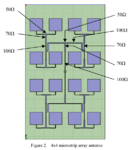promach
Advanced Member level 4
1. Why is 100 ohm transmission line used in this microstrip array antenna ?
2. Why A quarter-wavelength transformer of 70 ohm is used to match the impedance line of 100 ohm to the impedance line of 50 ohm. ?
3. Would a butler matrix be better than these simple impedance transformers in terms of reducing MIMO diversity issue ?
4. Is this stacked array antenna difficult to realize ?


2. Why A quarter-wavelength transformer of 70 ohm is used to match the impedance line of 100 ohm to the impedance line of 50 ohm. ?
3. Would a butler matrix be better than these simple impedance transformers in terms of reducing MIMO diversity issue ?
4. Is this stacked array antenna difficult to realize ?

